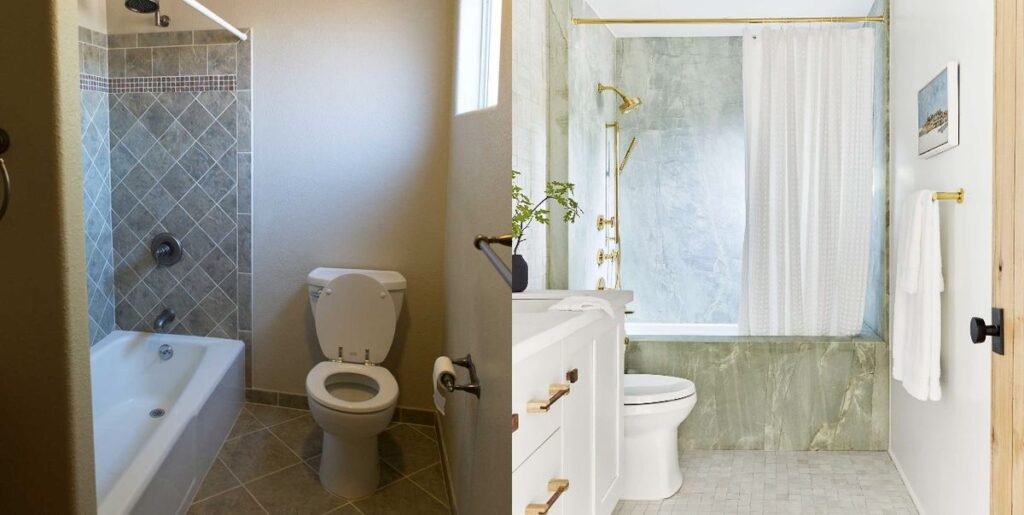Remodeling a small bathroom can be both a challenge and an opportunity to creatively maximize a limited space. Small bathroom remodeling requires thoughtful planning, clever design strategies, and careful selection of fixtures to make the most out of the space you have. Whether you’re looking to update the aesthetics, improve functionality, or increase the value of your home, this guide provides detailed insights into transforming your small bathroom efficiently and stylishly.
Understanding the Scope of Your Remodel
Assessing Your Current Bathroom Layout
Start your small bathroom remodeling project by evaluating the existing layout. Identify what works and what doesn’t. Does the current setup feel cramped? Could the space benefit from a different layout? Sometimes, even small adjustments to the placement of fixtures can make a significant difference.
Determining Your Needs vs. Wants
It’s easy to get caught up in all the exciting design possibilities, but it’s crucial to differentiate between what you need and what you want. Focus on needs to ensure functionality and use wants as optional enhancements if the budget allows.
Setting a Realistic Budget
Setting a budget is crucial for small bathroom remodeling. Remember to include a contingency fund for unexpected costs. Being realistic about what you can afford will help guide your decisions on materials, finishes, and changes in the layout.
Design Ideas for Small Bathrooms
Choosing a Layout That Maximizes Space
Opt for a layout that enhances functionality without feeling too cramped. Consider wall-mounted toilets and floating vanities to open up floor space, making the bathroom appear larger.
Creative Storage Solutions
In small bathrooms, clever storage is essential. Use mirrored cabinets, corner shelves, and built-in niches to keep essentials organized without occupying too much space.
Selecting Appropriate Color Schemes
Light colors can make a small space feel bigger and brighter. Opt for neutral tones like whites, creams, or pastels to reflect light better, enhancing the sense of space.
Best Fixtures for Small Bathrooms
Space-Saving Sink and Vanity Options
Choose a pedestal sink or a small vanity with storage to maximize space. Corner sinks are also a great option to consider for tiny bathrooms.
Choosing the Right Toilet Design
A wall-hung toilet with a concealed tank saves space and makes the floor easier to clean. Compact elongated toilets offer comfort while fitting into small spaces more efficiently than standard models.
Shower vs. Tub: Making the Smart Choice
For small bathroom remodeling, a walk-in shower can be more practical than a tub, saving space while offering a sleek, modern look. If you must include a tub, consider a shower-tub combo for versatility.
Lighting and Ventilation Solutions
Effective Lighting Techniques for Small Spaces
Good lighting is critical. Consider layered lighting solutions: ambient lighting for overall illumination, task lighting by the mirror, and accent lighting to enhance the bathroom’s features.
Ventilation Essentials to Prevent Mold
Proper ventilation is key to preventing mold and moisture damage, especially in small spaces. Ensure your bathroom includes a powerful exhaust fan or a window that can be opened to let out steam.
Smart Use of Mirrors to Enhance Lighting
Mirrors can reflect both natural and artificial light, making a small bathroom feel larger and brighter. Consider a large mirror above the sink or mirrored cabinet doors.
Choosing Materials and Finishes
Best Flooring Options for Small Bathrooms
Porcelain or ceramic tiles are great for small bathrooms because they’re waterproof, durable, and available in a variety of styles. Light-colored flooring can also make the space appear bigger.
Durable and Stylish Wall Materials
Water-resistant paint or ceramic tiles are excellent choices for the walls. They come in various colors and textures, allowing you to add visual interest without overwhelming the space.
Choosing Fixtures and Finishes That Last
Opt for high-quality fixtures that can withstand the humidity and frequent use typical of bathrooms. Brushed metal finishes are great for hiding fingerprints and water spots.
DIY Tips for Small Bathroom Remodeling
Simple DIY Projects That Make a Big Impact
Consider replacing old fixtures, painting the walls, or updating cabinet hardware. These are all manageable DIY projects that can significantly improve the look of your bathroom.
Tools and Resources You’ll Need
Arm yourself with the right tools for the job. Basic tools might include a drill, a saw, a hammer, and various hand tools. Always ensure you have everything you need before starting your project to avoid interruptions.
When to Call a Professional
While many aspects of small bathroom remodeling can be DIY, complex tasks such as plumbing or electrical work should be handled by a professional to ensure safety and compliance with local building codes.
Incorporating Technology
Innovative Tech Upgrades for Modern Bathrooms
Consider smart showers, automatic faucets, or a heated floor system to enhance your bathroom’s functionality and comfort.
Smart Storage Gadgets
Look for smart organizers, such as magnetic strips for securing small metal items like tweezers or bobby pins, and drawer dividers that help keep everything tidy.
Water-Saving Fixtures and Sustainable Options
Choose low-flow toilets, faucets, and showerheads to reduce water usage without sacrificing performance, which is not only good for the environment but also for your wallet.
Dealing with Plumbing and Electrical Considerations
Key Plumbing Concerns in Small Bathrooms
Plan your plumbing layout carefully to avoid costly mistakes. Ensure there is sufficient space for installation and maintenance around all plumbing fixtures.
Electrical Upgrades for Safety and Efficiency
Upgrade your bathroom’s electrical system to support new fixtures and appliances, ensuring all work is up to code and includes GFCI (Ground Fault Circuit Interrupter) outlets to prevent electrical accidents.
Layout Changes and Permit Requirements
Before making structural changes, check if you need permits. Altering the original plumbing or electrical layout often requires approval from local building authorities.
Maximizing Natural Light and Airflow
Tips for Enhancing Natural Light
If possible, enlarge windows or add a skylight to increase natural light, making the bathroom appear larger and more inviting.
Solutions for Improving Airflow
Ensure your bathroom design includes options for cross ventilation, such as windows or air vents, to keep air fresh and reduce moisture buildup.
Best Window Treatments for Privacy and Light
Use frosted glass or water-resistant window blinds for privacy without sacrificing natural light.
Accessibility and Ergonomics
Designing for Accessibility
Incorporate grab bars, a walk-in shower with a bench, and a higher toilet to make the bathroom accessible to everyone, regardless of mobility issues.
Ergonomic Design Features for Comfort
Ensure that all elements are placed for easy reach and use, from the height of the vanity to the placement of towel bars.
Safety Features to Include in Your Remodel
Non-slip flooring, rounded corners on fixtures, and adequate lighting are essential safety features in a bathroom remodel.
Final Touches and Decoration
Accessorizing Your Small Bathroom
Choose accessories that complement the overall design. Simple additions like plants, art pieces, or stylish soap dispensers can enhance the aesthetic without cluttering the space.
Choosing Décor That Enhances Space
Decorative elements should maintain the color scheme and scale appropriate to your small bathroom. Opt for functional decor that serves a purpose, such as decorative storage containers or minimalist wall art.
Final Checklist Before Finishing Your Project
Review every element of your remodel to ensure everything is in place, functions well, and looks great. Check for any unfinished areas or minor adjustments needed.
Common Mistakes to Avoid in Small Bathroom Remodeling
Overcrowding the Space
Resist the urge to add too many elements into your small bathroom. Focus on essentials to maintain a clean and open environment.
Neglecting Adequate Ventilation
Poor ventilation can lead to mold growth and damage to materials. Investing in a good ventilation system will protect your remodel in the long run.
Underestimating the Budget
Unexpected expenses can arise during remodeling projects. Keep a detailed record of all expenditures and maintain a buffer in your budget to manage unforeseen costs effectively.
FAQ: Small Bathroom Remodeling
1. How much does it typically cost to remodel a small bathroom?
Answer: The cost of remodeling a small bathroom can vary widely depending on the materials, fixtures, and whether you’re changing the layout or keeping it the same. On average, a small bathroom remodel can cost anywhere from $5,000 to $15,000. Always prepare for unexpected expenses by setting aside a contingency budget.
2. How long does a small bathroom remodel usually take?
Answer: The duration of a small bathroom remodel can vary based on the extent of the changes and the speed of the workers. Typically, a complete remodel can take between 3 to 6 weeks to complete, assuming no major structural changes and prompt availability of materials.
3. Do I need a permit to remodel my small bathroom?
Answer: In many cases, a permit is required, especially if you plan on changing the plumbing or electrical systems, or if structural changes are involved. It’s best to check with your local building department to understand the specific requirements for your area.
4. What are the best ways to make a small bathroom appear larger?
Answer: Utilizing light colors, adding mirrors, and employing space-saving fixtures like floating vanities and corner sinks can make a small bathroom feel larger. Also, good lighting and simple, streamlined designs help enhance the perception of space.
5. Can I do any part of my small bathroom remodel myself?
Answer: Yes, some tasks like painting, installing simple fixtures, or upgrading hardware can be DIY projects. However, tasks involving plumbing, electrical, or structural changes should be handled by professionals to ensure safety and compliance with local codes.
6. What are the best materials to use for a small bathroom floor?
Answer: Porcelain and ceramic tiles are popular choices due to their durability, water resistance, and ease of maintenance. They also come in a variety of styles and finishes suitable for enhancing the appearance of a small space.
7. What should I consider when choosing a toilet for a small bathroom?
Answer: Look for compact models, such as those with round bowls or wall-mounted designs, which take up less space than standard toilets. Also, consider one with dual-flush technology to help save water.
8. Is it worth installing a bathtub in a small bathroom?
Answer: This depends on your personal preferences and lifestyle. If you rarely take baths, installing a shower-only can save space and make the bathroom feel larger. If you enjoy baths or have young children, a small tub might be worth the space it takes up.
9. How do I choose the right vanity for a small bathroom?
Answer: Choose a vanity that fits the scale of your bathroom. Consider models with storage to maximize space, and think about a floating vanity to create a sense of more floor area.
10. What lighting is best for a small bathroom?
Answer: Opt for multiple layers of lighting such as overhead for general illumination, task lighting near the mirror for grooming, and accent lighting to enhance design features. LED lights are a good choice for energy efficiency and longevity.
Conclusion
Small bathroom remodeling can dramatically improve your home’s comfort and value. With the right planning and creative solutions, even the smallest spaces can transform into functional, stylish bathrooms. Start your project today and enjoy the benefits of a beautifully remodeled bathroom that meets all your needs and reflects your personal style.

